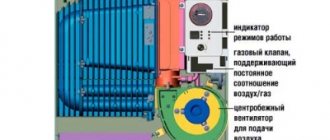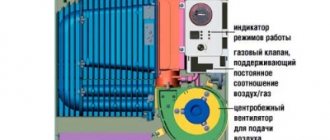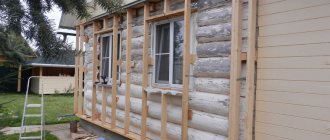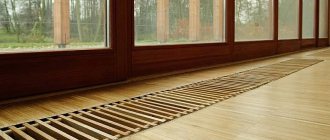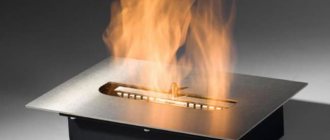Here you will learn:
- What is a gas convector
- How to install a gas convector
- Finally
Gas convectors are not as popular as their electric counterparts. Gas-powered devices require a centralized gas supply or cylinder, and are also not as safe. But gas models are cheaper to use, so they will be an excellent solution in a country house or cottage, where constant maintenance of heat in the room is not required.
Principle of operation
The basic principle of operation of a gas convector using bottled fuel is the process of natural heat exchange, in which heated air rises and cold air sinks to the floor surface.
The continuity of this movement allows you to maintain the set temperature in the room. In addition, in addition to natural convection, artificial injection of air masses can be additionally used. In this case, heat exchange accelerates and the air heats up faster. In fact, the entire process of equipment operation comes down to the following points.
- Gas flows to the burner.
- Cold air enters the technological openings on the body - air intakes.
- Passing through the device, the air masses heat up, enter the room, rise and circulate further.
- Combustion products are discharged through a coaxial chimney outside the room.
Gas convectors with a cylinder connection do not require access to main communications. In this case, the main source of fuel entering the combustion chamber becomes the tank in which the pumped propane is under pressure. In addition to conventional cylinders, options with liquefied gas can be used - in this case, the operating time of the device on one refill will increase by 2-3 times.
Models of gas convectors can be wall-mounted or floor-mounted. The first group of devices is mounted on a rigid connection to the wall surface in a vertical position, without moving during operation. Floor-standing devices can be mobile, equipped with rollers for movement, or stationary.
The design of a gas convector with cylinder fuel contains the following components:
- a burner with an igniter used to burn fuel in a closed chamber;
- heat exchange element;
- gas trap and chimney pipe;
- thermal relay to maintain a given temperature;
- automatic system that shuts off the fuel supply in the event of a device malfunction;
- housing with technological holes to ensure heat exchange processes.
An optional fan is installed to pump air. In addition, inside mobile equipment you can find a compartment for installing a gas cylinder of a certain size. “Home” stationary convectors use a connection through flexible gas hoses with the cylinder removed to a special outdoor cabinet, as required by fire safety rules.
Gas heater. Flaws in work
Next, you should deal with the disadvantages of convectors. The main disadvantage of such a device is that you have to break through the wall to complete the installation. Moreover, a hole is needed here for the coaxial gas outlet, which is a special tube in the pipe through which exhaust gases exit. The fresh air required for combustion is supplied to the convector thanks to an external pipe. It can be assumed that the hole in the wall may be located in a certain area where the convector itself will be placed. If they are located under every window of every room, then there will be a lot of holes in the walls, and they cannot be hidden or placed in one area. In addition, additional space must be made in the wall for the gas supply.
If a standard heating system is used in a living room with an area of 30 square meters with two windows, almost under each window it would be worth installing one convector. However, with gas convectors this option is unacceptable. Here you should install one convector with increased power in a certain area on the outer wall of the room (where there are the most optimal conditions for supplying gas and creating a discharge for exhaust gases). This installation does not imply creating a temperature balance in the room. One corner will be quite hot, and the other will be cold. To create proper comfort, one low-power convector should be placed under each window. However, here the question of price arises, which will double, although the aesthetics of the room will increase. Hence the conclusion - the installation of this heating option will be in many ways inferior to a standard water heating system.
The gas convector includes low inertia. In other words, it heats up quite quickly and cools down at a similar interval. This feature can be attributed to both pros and cons. It all depends on how the device is used. Using it in a residential area can negatively affect the comfort of the temperature regime, but installing it in a garage, barn or workshop will undoubtedly give positive results.
Another nuance in the operation of a gas convector, which can also be considered a plus and a minus, is the presence of a combustion chamber, where the gas heats the chamber, which subsequently heats the air. For the durability of the convector, its design must contain steel that is resistant to fading. It’s good if the device is equipped with just this type of specialized steel (however, the price of the device will double). If the convector uses cheap steel, then it runs the risk of failing very quickly due to corrosion, burnout and other factors. If the combustion chamber in the convector is created using 10 mm cast iron, then the service of the device will be durable.
Premises requirements
Gas service requirements for premises:
Ceilings should be no lower than two and a half meters, which is important, because many wooden houses are built with low ceilings, and this is with the least powerful equipment; The diameter of the ventilation duct must be equal to or exceed 100 mm, the material from which it is made must comply with SNIP, and the lower part of the ventilation duct must be at least 200 mm below the ceiling; Bottom gaps on interior doors must be at least 25 mm; Each room should have windows to ventilate the room; The boiler room must be equipped with a door to the adjacent non-residential premises, and when installing a boiler with a power of over 150 kW, a separate entrance door; The internal space of the boiler room must have at least 7.5 m3 in volume; for new houses this requirement has been doubled; The chimney must be equipped with two walls, its diameter must be greater than or equal to the incoming pipe of the equipment; Lighting in the boiler room must be safe; for this purpose, open light bulbs without shades are not allowed; In the case of external electrical wiring, it must be placed in specialized cable channels; The indoor gas control system should be installed in a wooden house if the boiler is located in the basement.
Sandwich chimney device
For a wooden building, this system is an ideal option.
Such a chimney consists of two pipes of different diameters located one inside the other. A heat insulator is placed between their walls. Such a chimney installed in a wooden house differs from a traditional brick one in a lot of advantages. Watch the video about the sandwich pipe:
The roof structure, made of wooden materials, even when dried well, seems to play a little over time. Displacements invisible to the eye and seemingly insignificant can lead to the destruction of a brick chimney, even the hardest one. But the sandwich, thanks to its design features, is not afraid of these threats.
And it is not surprising that the chimney in a wooden private house is increasingly being made in exactly this way. All its many advantages include the excellent fire safety of the pipe compared to a brick pipe.
Purpose
The convector is designed to run on natural gas for heating premises for various purposes. In this case, combustion occurs in a closed chamber, air is supplied from the street and combustion products are discharged there. The heat released during fuel combustion is transferred to the combustion chamber body and heat exchanger, and then to the indoor air. Due to rapid heating, the air rises, making room for colder air, maintaining an active convection process throughout the room.
A gas convector heats the air faster and more actively than its electric counterparts or, especially, converter-type radiators for a water heating system. This is due to the higher surface temperature of the heat exchanger and the increased rate of heat transfer from the combustion chamber.
A gas convector is an excellent solution in the following situations:
- The main heating of a small room or house with one or two adjacent rooms.
- As a replacement for a solid fuel stove, which was previously used to heat the house.
- For quick warming up and maintaining a comfortable temperature in the garage, utility room, or small country house.
- As an addition to the central heating system in rooms where installing a water radiator is difficult (basement and semi-basement, attic, veranda, etc.).
- For heating greenhouses.
As a replacement for main heating, a gas convector is only suitable for small houses or individual rooms. The efficiently heated area is easily calculated based on the available power models of gas convectors. Devices with a power of 2.5-6 kW are more often found on sale, less often up to 12 kW. In the first case, the convector is enough to heat a room up to 50 m2. The most powerful models are in demand only for industrial and public premises with an area of up to 100 m2.
Equipment startup and performance check
Before you start using your new heating device, it is important to conduct a test run. You should proceed according to this scheme.
- Open the gas valve and check the system joints for leaks.
- After checking, you can turn on the convector. For the first time, you need to hold the start button for 1 minute and wait until the gas penetrates the combustion chamber.
- Do you see the burner lit? Now you can adjust the operation of the convector.
Important: installation of a gas convector in a wooden house is absolutely safe, because fire hazardous parts are located in the inside of the heater.
To summarize, we note: despite the fact that a gas heater is not a very popular heating device, it can be used to create a comfortable temperature in dachas and country houses. The unit quickly and efficiently heats the air in the room, and at the same time is much more economical than an electric radiator. Another obvious advantage is the ability to connect to a gas cylinder. One dubious circumstance can be considered that the gas convector heats only one room, and not the whole house, unlike a gas boiler connected to the heating system.
We hope that the article was useful and helped resolve the problem!
Advantages and disadvantages
Such convectors have both their advantages and disadvantages, which the reviews clearly show.
Among the advantages are the following:
- Heating a dacha with a gas converter is suitable for virtually any type of premises, since there are no space restrictions for equipment.
- They have a compact size and excellent design. Thanks to this, they can fit into any type of interior.
- To install such devices, there is no need to take into account the location of the heating system pipes. There is also no need to take into account their slope or the dependence of heating devices on each other. Installation of such convectors is not difficult.
- Heating a country house with gas convectors does not depend on adjacent premises.
- Gas convectors are highly resistant to freezing.
- In terms of efficiency, some gas convectors are superior even to the latest generation gas boilers.
Modern gas convectors have a beautiful design
. However, gas convectors also have some disadvantages, among which are the following:
- A gas convector can only heat one room.
- Heating with gas convectors cannot be used to heat water.
- They have rather limited thermal conductivity. Most gas convectors have a power of 2 to 7 kW.
- Gas convectors are not as compact as water convectors, so it is quite difficult to disguise them.
- In residential areas, hot water was always needed. Double-circuit gas boilers will be able to fully satisfy this need for residents, but gas convector heating will not.
- Gas convectors have a rather beautiful design, but thanks to gas boilers you can use compact radiators or a heated floor system that is completely hidden from view.
- The efficiency of gas convectors is approximately at the same level as that of gas boilers.
Gas convectors are large in size
Gas supply main stages
The installation of the gas convector has been completed, now we need to get started with the gas supply. This stage is quite complex and responsible at the same time. To supply gas, do the following:
- According to regulatory documents, the pipe leading to the convector must go along the street. There are two options here: the first is that the pipe has a pre-installed threaded connection, the second is that there is no such connection. If there is a thread, then you can screw on the gas valve yourself, which will shut off the gas supply to the convector. If there is no withdrawal, one must be made. To do this, call professional gas welders from your local Gorgaz or similar office.
- After installing the gas tap, it is necessary to run a metal-plastic pipe to the convector itself. Using a tape measure, calculate the length of the pipe, simultaneously determining the presence of fittings.
- You need to buy pipe and fittings. The principle of purchase is that the seller must clarify the availability of a certificate of conformity of these pipes and fittings for this type of work.
- Lay the pipe, secure it with clips every m. To install the clips, you need to drill holes in the wall.
- When installing the necessary fittings, carefully lubricate the pipe and the fitting itself with silicone, which will provide additional sealing. Silicone will also serve as a lubricant and will make pipe installation easier.
As a result of the work, you should receive a convector mounted on the wall with a gas pipe connected to it.
Now the last stage of installation remains. A test run is required.
Before starting, open the gas tap and go over all fitting joints and threaded connections with a brush moistened with a water solution of soap or shampoo. This way you will be able to notice inflated bubbles (if any), which indicate gas leaks. If this happens, immediately turn off the gas supply valve. After checking the joints, start the convector. To do this, hold down the gas button for one minute. This way the gas will have time to pass through the pipes and enter the combustion chamber. Press the piezo igniter, a spark should ignite the gas. A blue flame will flare up in the firebox.
Adjust the operation of the convector by setting a comfortable temperature. During the first few hours of operation, you may smell an unpleasant odor of burning oil. This is normal, since the convector is new and the combustion chamber burns out. If the smell lingers for a long time, then you should turn off the gas and check all joints and threaded connections again.
It is advisable that all work on the installation of gas convectors be carried out by a professional who has sufficient experience in performing such work. This is also due to the fact that installing a convector yourself may void your warranty on the device. The gas convector must be accepted into the balance sheet by Gorgaz.
You must have a documented permit for the tie-in. In addition, all installation decisions, as well as the conclusions of the commission for acceptance of the device into operation, must be documented and signed in the appropriate manner.
The current market for heating devices is quite wide. Among such devices, it is worth highlighting the gas convector. The range of heating systems includes a lot of gas convectors of various shapes.
What is a gas convector
It should be noted right away that a convector is not a type of boiler; it works not only on a different principle (it heats not the coolant, but the air in a certain room), but also has a slightly different area of application. Most often, gas heaters are used in small houses where there is no need for constant heating. They can only heat the room where they are installed.
What does a convector consist of?
The design of the device is not too complicated, it includes:
Diagram of a standard gas convector with a fan for forced convection.
- a heat exchanger that heats the air;
- programmer – a device for controlling and maintaining room temperature;
- control panel, which contains various indicators;
- gas valve to control gas supply;
- a fan supplying air to the valve and heat exchanger;
- a fan that provides forced supply of warm air into the room.
Gas convector - operating principle
As you can see from the diagram, everything is quite simple. The convector plays the role of a gas burner; cold air enters from below under the influence of convection, heats up and exits through the hole at the top.
The device works quite simply: the operating principle is based on the phenomenon of convection - warm air rises when heated and cold air falls. Gas models can operate using either natural or forced convection. In the latter case, a special fan is used to supply air.
Advantages and disadvantages
The quality of the device itself, as well as its performance, depend on the price. By choosing a cheap model, you will not save money, since the device may last you less than a year. Repairs in the current situation will not be cost-effective. Therefore, we will consider the advantages and disadvantages based only on high-quality devices. So, the pros:
- efficiency and quick heating of the room;
- easy installation of a gas convector with your own hands;
- there is no need to make a heating system (water);
- low price;
- unlike electric analogues, gas models do not burn oxygen;
- completely autonomous operation mode;
- not connected to electricity (except for convectors with forced circulation);
- It is possible to connect the heater to a gas cylinder.
But gas convectors are not without their disadvantages:
- if gas is used from a centralized system, then it is necessary to obtain permission to connect the device;
- it is necessary to punch holes in the wall outward where the heater will be mounted;
- considerable dimensions;
- if you decide to install several convectors, then gas will have to be supplied to each of them, and only from outside the building.
Types of convectors
Devices can be classified by their power, as well as by design. If everything is clear with power: choose the one that can heat the room, then with the types of performance things are a little more complicated.
There are two types of heaters:
Wall-mounted models can fit very well into the interior.
- Floor-standing – devices are installed on the floor and do not require special installation skills. Such a convector can heat a fairly large room (even an industrial one), but it is heavy and requires a special base.
- Wall-mounted are more compact models that fit well into the interior of the house. Often the devices are mounted under the window to create a thermal curtain from cold air passing through the glass. Convectors of this type have low power, so they are only suitable for heating rooms in houses up to 100 square meters.
When choosing a convector, you should also pay attention to the material of the heat exchanger. The latter can be made of steel, cast iron or copper
Nowadays, models with a steel heat exchanger are more common, but cast iron ones have greater efficiency due to the properties of the alloy, and are also able to last longer. Their only drawback is their heavy weight. Copper analogues are effective and durable, but expensive.
Required tools and installation diagram
The next step after purchasing the device is preparation for installation. Make sure you have the following materials and tools on hand:
- pipe cutter,
- drill,
- drill,
- adjustable wrench,
- spanners,
- screwdrivers,
- hammer drill,
- spatula,
- silicone (plumbing, high temperature),
- screws and dowels,
- gas tap.
Now you can move on to the next stage - choosing the installation location.
It is important to act in accordance with GOST! Before you begin installation, take careful measurements, markings and “trying on” the convector. Please note that the room in which you plan to install the heater must be prepared. Remove furniture from the room or cover furnishings with polyethylene, since working with a hammer drill is a rather dusty business.
Installation of a gas convector is carried out according to the following scheme.
- Decide where the hole for the gas pipe entry will be.
- Make a hole in the wall with a hammer drill, focusing on the diameter of the future pipe. This stage is the most labor-intensive.
- The next step is to drill holes for the heater mounts and hammer in the dowels.
- Connect the convector to the exhaust pipe. Be sure to seal the joint with silicone that can withstand high temperatures.
- The heater is attached to the wall with self-tapping screws. At this stage you will need help, because the unit has an impressive weight.
- The final stage of installation is to fill holes and cracks with foam to prevent cold air from entering the room.
We bring to your attention an educational video dedicated to the installation of a gas convector.
Advantages of backup heating of the house with liquefied gas from cylinders
In the article: “House heating with gas cylinders. Personal experience”, we explained in detail whether it is profitable or not to heat a cottage with liquefied gas. To summarize the material, this option is worth considering:
- If the house has a small area (about 50-70 sq. m).
- The house is well insulated.
- The property owner has no other alternative, and the allocated power of the electrical grid is not enough to afford cheap heating with electricity at the night tariff.
To this we add the constant loss of time and money (for gasoline), because... The owner of a liquefied gas heating system will most likely have to take cylinders to refuel weekly.
Therefore, we will consider heating with gas cylinders only as a temporary, backup and energy-independent heating system, so as not to freeze in winter and somehow survive for 2-3 days in case of failure of the main heating system or a power outage.
I built a frame house with an area of 90 square meters. m in the form of a coaxial yurt. The house is currently being used in the “dacha” mode, i.e. I only come there on weekends. There is no main gas. Electricity is one phase. The voltage fluctuates from 150 to 230 Volts. There are no long outages, but once a truck knocked down a power pole. No one is immune from emergency situations. I was wondering how I could heat the house, and this is what I came up with.
The user analyzed all types of heating available to him:
- solid fuel stoves-fireplaces;
- gas tanks;
- electric boilers;
- IR heaters;
- heat pumps;
- alternative energy.
As a result, electric and gas convectors turned out to be the easiest to install, cheapest in cost, easy to use and easy to automate. Moving a little away from the main topic of the article, let’s say that electric convectors are controlled through timers and thermostats. This allows Dekagon to arrive for the weekend (by Friday evening) to raise the temperature in the house from the “standby” level to a comfortable level in advance. Those. from + 15 °C to + 23 °C and do not waste time warming up the premises.
Now the arguments for using a body generator powered by liquefied gas are interesting.
When my house was being built in winter, the builders lived in a change house. There was no electricity either. I was thinking about how to warm the workers. I wanted to buy them a “potbelly stove”, but a good solid fuel stove is expensive. We still need to install a chimney. Harvest, store, saw, chop firewood. Extra hassle. I took a gas convector with a power of 2.2 kW. In 2014, it cost me 8,500 rubles. The device is immediately ready for use, just connect it to the cylinder. During operation, the gas convector showed its best side. Works efficiently and safely, autonomously. The thermostat keeps the set temperature. In general, I liked it so much that I decided to move it into the house in case of a power outage.
For gas, the user bought a modern composite (rather than heavy steel) 24 liter cylinder. I also additionally purchased a kitchen tile with two electric and two gas burners.
A year later, Dekagon bought a stationary gas fireplace with a capacity of 7 kW.
The fireplace operates from a second gas cylinder, is automatic, and combustion products are discharged through a coaxial chimney.
Installation of a gas fireplace or convector is not difficult and is accessible to everyone. The user made a hole in the wall, hung the heat generators on the wall and connected them to gas cylinders.
Bottom line: Dekagon heats the house with electricity and from time to time gas heat generators. Let's look at the costs for a combined heating system. So, the heating season lasts 7 months. In addition to electric and gas convectors, the house is equipped with infrared electric heaters and several IKZK lamps. Water for domestic hot water is heated from electricity. Household appliances, lighting, etc. work.
- Electricity consumption for the heating season 2014-2015 is 8000 kWh.
- Electricity consumption for the heating season 2015-2016 is 6800 kWh.
In the 14-15 season, the electricity tariff is 3.15 rubles. for 1 kWh. Total (8000 x 3.15 = 25,200 rubles) / 7 months. = 3,600 rub. 1 month for electricity.
In the 15-16 season, the electricity tariff is 3.45 rubles. for 1 kWh. Total (6800 x 3.45 = 23,460 rub.) / 7 months. = 3,350 rub. 1 month for electricity.
Liquefied propane-butane gas (LPG) is used as backup heating and for cooking. During the season, 3 cylinders (20 liters of gas) are used. This is about 1200 rubles.
Rules for proper operation
Only adult users who have carefully studied the manual and operating recommendations can turn the gas convector on and off and adjust its operating modes. It is unacceptable for the younger generation or incapacitated people to participate in these processes. If it is impossible to protect the gas convector from their interference, then it is better to refuse to install the device in advance.
The room in which the gas convector is planned to be used must be ventilated, which requires the presence of a window or at least a vent. It is advisable that the door leaf have ventilation grilles
Remember that if a specific gas smell is detected in the room, the tap at the entrance to the convector should be closed immediately. Under no circumstances should you “spark” in such a situation: strike matches, turn on the lights, use a lighter, etc. If these requirements are not followed, a seemingly small leak can cause a devastating explosion.
The room in which a leak was discovered must be immediately ventilated by opening the windows and door wide. You should immediately call the employees of the gas organization that connected your device to the centralized mains, or the emergency service. It will be possible to operate the gas heater only after the leak has been completely eliminated or the device has been repaired.
How to maintain a trench convector?
Like any other heating equipment, trench heating convectors require periodic cleaning. This is done using a vacuum cleaner, after removing the protective grille. Clean the finned surface of the heat exchanger, using a brush if necessary, to remove dirt and dust. The grill itself can be washed with water.
During hydraulic tests, when the pressure in the heating system exceeds the nominal one, it is necessary to make sure that the convectors do not leak. To do this, just open the grille and inspect the box. If it is dry, it means that the convector has passed the test with honor.
Subject to the installation and maintenance rules, in-floor water heating convectors will bring warmth to your home without violating the overall design idea. A convector installed in front of the front door can trap up to 90% of cold air when it opens and create a thermal curtain. At the same time, they are silent, look stylish and, thanks to the variety of colors, fit perfectly into any interior, giving coziness and comfort.
With or without a fan?
Fans on in-floor water convectors significantly increase the power of the system as a whole, since they force air through the radiators. Using fans, you can absolutely precisely regulate the volume of air passing through and, accordingly, the air temperature in the room. Of course, such a system upgrade will take a little more money out of your pocket, but if you are ready to spend money for greater comfort, feel free to install it, you won’t go wrong!
conclusions
Undoubtedly, gas convectors are the most popular type of heating appliances today for small residential, household facilities and even vehicles. The difficulty is that the most affordable and affordable type of fuel can be dangerous if the operating instructions are violated.
If the rules of use are strictly followed, there will be no threats to life, health, or property. Homemade products will not create any risks if the gas moves through sealed circuits. However, if there are doubts that you can ensure tightness, it is better to buy a factory-made device and not tempt fate.
Would you like to talk about how you installed and connected your own gas convector? Perhaps you have an interesting idea for assembling or upgrading a gas heater? Please leave comments in the block form below, ask questions and post photos on the topic of the article.
Mounted gas boiler
Diagram of a mounted gas boiler.
Heating via a mounted gas boiler is convenient due to its lightness and small size. It must be mounted on a load-bearing wall. The mounting rail is placed at a height of 1 meter square meter to 1.6 m. For the exhaust of a coaxial type chimney, it is better to use a detailed diagram. The pipe diameter must clearly correspond to the boiler opening. Self-connection of the boiler to the gas pipe is carried out using a rubber hose, but it is much better to ask gas wiring organizations for help.
Then you should make sure that the connection is tight by applying a soap-based solution to the threads of the connection joints.
Heating from a gas-fired boiler is considered one of the most economical and environmentally friendly types of heating systems for wooden houses. The range of the heated area of one boiler can reach about 350 m2
When selecting the power of a gas-fired boiler, it is necessary to take into account that for every 10 m2 1 meter square meter sq. kW is enough. There are double-circuit and single-circuit boilers. General heating is installed using single-circuit heating systems, while double-circuit heating systems must, in addition to this, solve the issue of hot water, heating from 60 to 200 liters of hot water
There are also 2 types of ignition: automatic and manual, activated with a button. There are natural and forced draft of boilers. If the removal of exhaust gases is carried out due to the draft created in the smoke exhauster, then this is a natural draft gas water heater. When gases are removed using a built-in fan, it is a forced draft boiler
General heating is installed using single-circuit systems, while double-circuit systems. In addition to this, the issue of hot water must be resolved, heating from 60 to 200 liters of hot water. There are also 2 types of ignition: automatic and manual, activated with a button. There are natural and forced draft of boilers. If the removal of exhaust gases is carried out due to the draft created in the smoke exhauster, then this is a natural draft gas water heater. When gases are removed using a built-in fan, it is a forced draft boiler.
When installing a gas-fired boiler in a wooden house, any installation process and installation must strictly comply with repair and technical regulations and strictly follow safety needs. Control devices for gas-fired boilers have automatic functions. The housing contains burners, a heat exchanger, a device for determining pressure, a security system, circulation pumps, a thermometer, and an expansion tank. Installing a gas-fired boiler without outside help, without the services of heating system companies, is quite possible. Everything related to the installation of the device itself, the installation of pipes for the water supply system and the connection of electrical power can be done with your own hands.
However, it is better to contact special organizations regarding gas distribution. A gas heating boiler is the most popular method of general heating system today. Inexpensive organization, installation and work make it possible to choose in favor of purchasing and installing gas-fired boilers for wooden houses.
Gas water heaters for heating systems
More details on the website ust-stroy.ru
Gas connection
Friends, at this stage it is important to be extremely careful! Let's say that you do not have the skills to work with gas appliances - then to perform the following work it is better to turn to specialists.
Installation of a gas heater to a gas supply source proceeds according to the following algorithm.
- Let's imagine that there is a special threaded outlet on the gas pipe. Then you just need to screw a gas valve onto this pipe. If there is no special allotment, then one will need to be made!
- The next step is to bring the gas pipe to the convector and connect them using a fitting. This process cannot be rushed.
- Secure the supplied pipe with special clips. The distance between them is 1 meter. To do this, you will need to drill holes on the outside wall of the building.
- Treat fittings and pipe joints with silicone to ensure a tight seal.
- Be sure to call your gas service representative to ensure proper installation and connections.
What is a gas convector
It should be noted right away that a convector is not a type of boiler; it works not only on a different principle (it heats not the coolant, but the air in a certain room), but also has a slightly different area of application. Most often, gas heaters are used in small houses where there is no need for constant heating. They can only heat the room where they are installed.
What does a convector consist of?
The design of the device is not too complicated, it includes:
Diagram of a standard gas convector with a fan for forced convection.
- a heat exchanger that heats the air;
- programmer – a device for controlling and maintaining room temperature;
- control panel, which contains various indicators;
- gas valve to control gas supply;
- a fan supplying air to the valve and heat exchanger;
- a fan that provides forced supply of warm air into the room.
Gas convector - operating principle
As you can see from the diagram, everything is quite simple. The convector plays the role of a gas burner; cold air enters from below under the influence of convection, heats up and exits through the hole at the top.
The device works quite simply: the operating principle is based on the phenomenon of convection - warm air rises when heated and cold air falls. Gas models can operate using either natural or forced convection. In the latter case, a special fan is used to supply air.
Advantages and disadvantages
The quality of the device itself, as well as its performance, depend on the price. By choosing a cheap model, you will not save money, since the device may last you less than a year. Repairs in the current situation will not be cost-effective. Therefore, we will consider the advantages and disadvantages based only on high-quality devices. So, the pros:
- efficiency and quick heating of the room;
- easy installation of a gas convector with your own hands;
- there is no need to make a heating system (water);
- low price;
- unlike electric analogues, gas models do not burn oxygen;
- completely autonomous operation mode;
- not connected to electricity (except for convectors with forced circulation);
- It is possible to connect the heater to a gas cylinder.
But gas convectors are not without their disadvantages:
- if gas is used from a centralized system, then it is necessary to obtain permission to connect the device;
- it is necessary to punch holes in the wall outward where the heater will be mounted;
- considerable dimensions;
- if you decide to install several convectors, then gas will have to be supplied to each of them, and only from outside the building.
Choose models with a built-in fan. They are more efficient than their fanless counterparts.
Types of convectors
Devices can be classified by their power, as well as by design. If everything is clear with power: choose the one that can heat the room, then with the types of performance things are a little more complicated.
There are two types of heaters:
Wall-mounted models can fit very well into the interior.
- Floor-standing – devices are installed on the floor and do not require special installation skills. Such a convector can heat a fairly large room (even an industrial one), but it is heavy and requires a special base.
- Wall-mounted are more compact models that fit well into the interior of the house. Often the devices are mounted under the window to create a thermal curtain from cold air passing through the glass. Convectors of this type have low power, so they are only suitable for heating rooms in houses up to 100 square meters.
There is another subtype of heaters - built-in. They can be installed in the floor or wall, and not only do not spoil the interior, but also decorate it. In terms of parameters, such models do not differ from wall-mounted ones. But installing them is more difficult, since it is necessary to prepare a niche for the device in advance.
When choosing a convector, you should also pay attention to the material of the heat exchanger. The latter can be made of steel, cast iron or copper
Nowadays, models with a steel heat exchanger are more common, but cast iron ones have greater efficiency due to the properties of the alloy, and are also able to last longer. Their only drawback is their heavy weight. Copper analogues are effective and durable, but expensive.
All convectors under consideration are closed. Open ones also exist, but they take the air necessary for gas combustion from the room, and the waste enters the general ventilation. Due to these properties, it is highly not recommended to install open-type heaters in residential premises.
The process of installing a gas convector in a wooden house
There is nothing easier than fixing the converter to a wooden wall; for this you will need:
- Self-tapping screws;
- Crosshead screwdriver;
- Fastenings (included with the converter);
- Building level;
- Pencil.
First, you should check at what distance from each other are the loops by which the gas convector is hung. Most often, they are wide enough, which allows you to move it left and right, already on the mounts, to a distance of about 5 cm.
Measure the distance between the centers of the seats; it will be the same for the upper and lower hinges. Transfer these dimensions to the wall, observing the height you need from the floor, most often it ranges from 10 to 20 cm.
Attach self-tapping screws to the designated points, and double-check with the help of a convector whether the distances match by bringing it to the heads of the screws. If this is the case, then you can safely fix the hooks to the wooden wall.
When the fasteners are screwed, put a level on them and check the inclination relative to the horizon; it can be leveled by loosening one of the fastenings and lifting it slightly. Now you can hang the gas convector on a wooden wall.
Gas boiler for floor
A gas boiler for the floor is mounted either on a concrete base or on an aluminum sheet protruding at least 300 mm beyond the perimeter of the device. If this is a closed chamber combustion system, then a coaxial type chimney is used, the opening of which can be located either on the back wall of the device or on the top panel. The chimney must be placed away from the window to prevent gases from penetrating back into the room. The smoke exhaust pipe must have a slope to remove condensate due to the temperature difference. When installing vertical heating equipment, the hole for the smoke exhauster in the top panel must be at least 15 centimeters higher than the equipment itself. After the installation of the chimney is completed, you can turn on the water supply devices.
If you need to determine a gas water heater for individual buildings, then the device must be placed in a specialized pocket, which has a recess of about 30 centimeters with a concrete screed and walls lined with fireproof materials.
Convector installation
Before installing a gas convector, you must study the installation requirements and recommendations, which are described in the instructions for the device.
Before installing the gas convector, you need to choose a place to place it. According to GOST, the unit must be mounted under a window.
The main installation steps are described below.
- We try on the device to the chosen location, using a tape measure we transfer the places for the holes for the chimney and gas pipe. In some models, the gas pipe is supplied from below, so it is necessary to leave space for its connection.
- After this, the most labor-intensive operation has to be performed - punching a large-diameter hole in the wall for the exhaust pipe. You can use a hammer drill and make a hole with a diamond bit. If you don’t have a crown, you can break through the wall by switching the hammer drill to jackhammer mode (when using the hammer drill, a lot of dust will be generated, so cover all the furniture with foil in advance).
- Next, you need to prepare holes for fasteners and hammer dowels into them.
- Now you can connect the pipe to the heater and treat the connection with sealant (high temperature).
- Lift the device together with the pipe and insert it into the hole in the wall, then secure the device with self-tapping screws. Since the unit is quite heavy, you will need help to lift it. The floor heating unit has special legs.
- After this, it is necessary to seal all the cracks between the chimney and the wall with high-temperature sealant or foam.
- At the end of the chimney, attach a cap that prevents the flame from being blown out by the wind (the cap and fasteners for it are included with the device) - the installation of the gas convector is completed.
In conclusion, we can say that the use of gas convection equipment can be a relatively simple and inexpensive solution to the heating problem for different types of premises. It is attractive that the installation of such equipment does not cause much difficulty (except for connecting the device to the main line).
During the cold season, various devices are used to heat the room. One of the most popular today is the gas convector. As a rule, after purchasing this device the question arises: how to install a gas convector?
If the installation is carried out in compliance with all requirements, the room will be warm and the device will function correctly without endangering you.
Advantages, disadvantages
Advantages:
- Easy to install and operate. It comes down to three steps: remove the packaging, hang it on the wall, plug it into the socket. The controls are intuitive.
- Reliability, long service life - up to 15-20 years. Virtually no moving parts, proven designs.
- Safety - maximum heating temperature of the thermoelement is 80 degrees. Fire and serious burns are not possible. Location on the wall or ceiling reduces the risk to a minimum.
- Environmentally friendly - does not burn oxygen.
- Efficiency - up to 97%.
- You can fit the convector into any interior by placing it on the wall, ceiling, or floor.
The disadvantage is the cost of electricity needed to operate. But, due to rising prices for other energy sources, the disadvantage is less noticeable in comparison with the advantages.
How to install a convector correctly
- Installation of a gas convector in a wooden house. During operation, the housing heats up to 50-55°C. It is necessary to insulate wooden surfaces in contact with heating parts of the structure. Installation rules in a wooden house require the manufacture of fireproof roof breaks. If a coaxial pipe is used, insulation is not required at the point where it passes through the wooden wall. The surface of the coaxial chimney heats up slightly due to the special design of the burner and pipe.
- Location from the floor. Air heating of a country house or residential building has certain features that affect the heating efficiency. To ensure maximum performance, the convector should be installed as close to the floor as possible. As a result of this solution, the intensity of circulation of convection flows increases and the efficiency of the equipment increases.
- The gas pipe is supplied to the heater exclusively through the street. A shut-off valve should be installed at the connection point.
A test run is carried out in the presence of a gas service representative. A corresponding note is made in the convector documentation.
Which is better, a gas convector or a boiler?
Air heating is recommended for use in country houses that are not heated in the winter. During installation there is no need to use a water circuit; the building can be heated only from time to time. Even at negative temperatures in the room, you can warm up the room in 20-30 minutes.
A gas convector for a home using bottled gas is inferior to a boiler connected to the main pipeline in terms of efficiency, but superior in functionality. The choice of an air heater is justified in the absence of gasification. With a fully charged cylinder, the heater will operate for approximately 10 days.
A convector heats a room better and faster and uses less fuel, but its effectiveness is limited by the properties of convection currents. The heating intensity decreases as obstacles arise: walls, furniture, etc.
For heating a country house or small rooms, a convector type heater is optimal. But for residential heated houses with large rooms, it is better to install a traditional gas boiler.
The current market for heating devices is quite wide. Among such devices, it is worth highlighting the gas convector. The range of heating systems includes a lot of gas convectors of various shapes.
When and why is it effective to use gas convectors?
Gas convectors have low resource consumption, but are not able to develop the required power to heat large rooms. Therefore, the scope of their application has become small private houses with one or two living rooms, cottages, garages and temporary buildings. In such conditions, the heating gas convector provides the following advantages:
- compactness, relative cheapness and ease of installation of equipment;
- no need to develop and approve project documentation;
- autonomy when the convector is powered from gas cylinders;
- high efficiency (up to 90% in industrial devices and up to 80% in home-made convectors);
- resistance to low temperatures, no “freezing effect”;
- using atmospheric oxygen rather than indoor oxygen;
- fuel versatility, that is, the ability to switch from methane to propane by replacing nozzles.
Among the disadvantages of the system, the most significant are serious losses in efficiency when heating large rooms and an increase in their warm-up time.
The second problem is partly eliminated by installing convectors with forced circulation, that is, equipped with a blower fan, however, in houses with three or more rooms, the rationality of such a solution is very doubtful.
Another problem that may arise when trying to convert an apartment for convector heating is a ban from the municipal gas service, caused by the potential danger of the device for neighbors. Therefore, residents of apartment buildings need to coordinate such work in advance.
How does a gas convector work?
Operating principle of convectors
- Inside the convector there is a heat exchanger connected to convection channels.
- The heat exchanger heats up when gas is burned.
- The air passes through the heating element and heats up.
- Heated air flows enter the room.
Advantages of gas convectors
- Lower gas consumption - the air in the room is heated directly, and not thanks to the coolant, which increases the efficiency of the equipment and reduces heating costs.
- No need for coolant. Heating of the room is carried out using air heating. Convectors can be installed in unheated rooms, starting only when necessary, without fear of freezing of the heating system. For this reason, installing a gas convector for a summer residence is the best option.
- Versatility - the heater is connected to a central gas pipeline or cylinders. For the convector to operate, a connection to a combustion products exhaust pipe is required. Connection to the power supply network is necessary only for convector models with a fan. The fan accelerates air circulation and increases the rate of heating of the room several times.
To install a gas heating convector in an apartment, you need to obtain permission from the gas service and prepare a heating project, the same as for a hot water boiler.
Selecting a convector
How to choose a gas convector? First of all, attention is drawn to the technical characteristics of the unit. The best option is a device with a closed combustion chamber and a cast iron heat exchanger
The presence of a programmable control unit is considered important. Let's look at other factors that you should pay attention to when choosing a household gas convector.
Device power
Since heating occurs due to air circulation, the units operate effectively in only one room. Therefore, each room will require the installation of a separate unit. Power is determined from the calculation: 100 W are required per 1 m2 of area.
Heat exchanger material
Since gas heating convectors operate on gas, which burns in a special chamber, the heat exchanger is exposed to strong temperature effects. If it burns out after some time, the device fails. Therefore, the material of this part must be resistant to high temperatures. The leader among materials for heat exchangers is cast iron. This metal is resistant to thermal stress; in addition, it cools very slowly and distributes heat evenly. Gas convectors with a cast iron heat exchanger can last up to 50 years. The main disadvantages of such devices are the high price and large mass of the unit. A heater with a steel heat exchanger is cheaper and lighter
But when choosing a unit, you should pay attention to the quality of the steel. Steel heat exchangers can last at least 20 years
Combustion chamber type
Heaters may differ in design based on the type of combustion chambers:
- Open combustion chamber. Installation of a unit with such a chamber requires the installation of a chimney with access to the roof. In addition, when the unit is operating, air will be taken from the room to maintain the combustion process. Therefore, good ventilation of the room is required.
- Closed combustion chamber. Such models are more popular because they do not require a pipe outlet through the roof (a coaxial pipe is installed opposite the device). And another advantage is that the oxygen in the room is not burned, since the air is taken from outside the building.
Availability of a fan
A gas convector with a fan quickly and evenly heats the entire room. Due to the forced air supply to the heat exchanger, the latter is cooled better. And since overheating is prevented, the service life of the heat exchanger is significantly increased.
Room type
If you want to install a convector in an apartment, then the best choice would be a device that has a closed combustion chamber and a chimney with a coaxial pipe. This type of device does not burn oxygen in the room. In private buildings, any type of heater can be installed. But when using a device with an open combustion chamber, the room must have fresh ventilation.
Type of fuel
The use of liquefied gas is prohibited in apartment buildings. Therefore, the device is connected only to the main line. In private homes, a gas convector using bottled gas can be used, provided that the bottle is installed outdoors in a special metal cabinet.
Amount of fuel consumed
Fuel consumption in gas heating equipment is considered economical. To calculate gas consumption, the following basic parameters are accepted:
- 1 kW of power will require 0.11 m3 of gas from the main;
- 1 kW of power will require 0.09 m3 of liquefied gas.
Based on these indicators, you can make a calculation. For example, a 4 kW heater (designed for 40 m2 of area) will consume 0.44 m3 of gas per hour of operation, and 10.56 m3 per day. But, since the device does not work constantly, this figure will be significantly less.
Similarly, you can calculate the flow rate for a gas convector running on liquefied gas.
How to choose a gas convector
When choosing equipment you will need to consider the following:
- Power calculation. When heating a room, air convection is used. Consequently, heaters are only effective in limited spaces. For each room you will need to install a separate convector. Power calculation is carried out according to the formula 100 W per 1 m².
- Type of housing. Heaters with a closed combustion chamber and exhaust of combustion products through a coaxial chimney are suitable for apartments. You can install any type of equipment in your home. But when installing a heater with a closed chamber, it is necessary to take care of a constant and intense flow of fresh air.
- Fuel type. A gas heating convector running on liquefied gas is prohibited from being installed in an apartment in a multi-storey building, due to the high explosion hazard of the cylinders.
All convectors are initially manufactured with the ability to connect to the main gas pipeline. If you plan to connect the gas convector to the cylinder in the future, you need to purchase a special reducer (in some modifications it is included in the kit).
Necessary materials
To install this device, you should have a set of necessary tools and materials on hand:
- the gas convector itself;
- metal-plastic pipe with metal fittings;
- pipe cutter;
- a wrench that is suitable for tightening the fittings used;
- silicone for plumbing work;
- gas tap;
- a powerful hammer drill with a special blade-shaped crown;
- drill;
- Phillips screwdriver;
- polyurethane foam that can withstand high temperatures;
- high temperature silicone;
- plastic dowels and screws for them.
Return to contents
